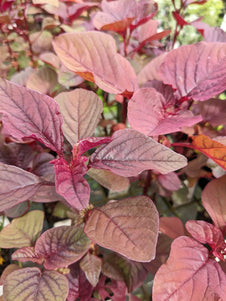
Amaranth Edible Red
Amaranth Edible Red

- In stock, ready to ship
- Inventory on the way

Usually available: September to March
Life cycle: Annual
Height: 1.5m
Position: Full sun
Soil preference: Well drained
This is how we pack and send your Herb Plants to all states except TAS & WA
You will receive
- 1 Amaranth Edible Red Herb Plant in a 50 X 75mm tube - General growing instructions
All of our Herb Plants are grown organically with certified organic potting mixes and fertilizers
Botanical Name: Amaranthus mangostanus
Amaranthus mangostanus is marketed as Edible Red, however some botanists claim it is simply synonymous with several other cultivars, such as A. tricolour (Garnet Red and Mira varieties). There are over 60 species of Amaranthus and botanists are undecided about the true classification of many varieties. Amaranths come in many sizes, colours and leaf shapes. Most varieties do not have a true common name, except to be called Chinese Spinach in some regions of the world. Identification of specific varieties is often from commercially derived marketing identities.
Amaranth - Edible Red is a fast growing, annual up to 1.5 meters tall and equally as wide, although many other varieties are smaller. The soft, delicate leaves are long and broad, up to 15cm and have a red blush to both the leaves and stems. The flowers are generally small, ranging in colour from crimson through to deep red. They are held aloft in long, terminal clusters up to 20cm long. The stems are fleshy and hold the plant upright, with the deeply veined leaves playing a supporting role to the ornamental flowers.
The seeds are very small, but also highly nutritious and can be harvested quite easily. The plant is said to be much more nutritious than other green leafy vegetables, and is a warm region substitute for spinach. Amaranthus varieties have been used as food sources for centuries and were highly valued as a food source for the Aztec communities.
Historically, the red amaranthus plant was held in high esteem and considered to be holy by the early Greeks. During these times the plant was believed to have special curative powers and was bestowed with the mark of immortality. It was used to decorate drawings of Gods and on tombs. The name, amaranthus, was derived from the Greek for immortality meaning ‘unwithering’. An interesting aspect of the Amaranthus genus is that it photosynthesises using a C4 carbon fixation pathway. This helps use light and water more efficiently in converting CO2 to carbohydrates. This process is more efficient in high temperature areas, with bright sunlight and dry conditions. Most plants use a C3 pathway, but others like maize, sorghum and sugar cane also use a C4 pathway.
Growing Conditions
The Edible Red amaranth is like most other varieties and originates from the tropical regions of the world, specifically India and East Asia. It prefers sunny, sheltered positions and may be found growing on roadsides and wastelands. However, most warm regions of the world have a type of Amaranthus growing as a native inhabitant. It will grow best in tropical areas, but will do well in temperate regions as well. It can grow all year round in tropical regions, but is otherwise frost tender.
It will tolerate a wide range of soil types, has some acid tolerance, and prefers rich, but well-drained soil. It is quite a tall, delicate and soft leaved plant, with wind protection is vital. Amaranth prefers a warm position in the sun and ideal conditions would include humidity, but this is not essential. Shade is not well tolerated.
The plant is self-fertile and will self-seed if allowed, ensuring a supply for the following year. It is easily wind pollinated and you may find plants growing in different parts of the garden. The seed can also be saved and you can sow it directly into the ground where soil temperatures are warm enough. Alternatively, sow into seed trays and plant out when frost and cooler conditions have passed. It is important to sow the seeds at least 15-25 mm deep because they do not like light conditions for germination. Alternatively, the plants will grow readily from cuttings. To collect the seed, simply hold a paper bag under or around the seed heads and collect them into the bag.
Culinary Uses
Amaranth is used as a spinach replacement and goes by the name Chinese Spinach in many regions. The leaves have up to twice or three times as much nutritional value, compared to other green leafy vegetables. They are rich in vitamins A and C, protein, iron, calcium and magnesium. The leaves, stem and seeds may be used and eaten raw or cooked. The older leaves are said to have a ‘hot’ taste, and have also been described as tasting like artichoke. The inner leaves are crisp and make a nice cooked vegetable dish. Generally, the leaves and stalks can be used as a hot weather spinach replacement. Include them in soups, stir fry dishes, salads or any other dish requiring green leafy vegetables. They are quicker to cook than spinach, so must be added right at the end of the cooking process.
The small, nutritious, seeds are used as a cereal substitute and can be cooked whole. They do become quite gelatinous and when eating them it is difficult to crush them all, so many will pass through the digestive system without passing on their nutritional benefits. Sprouted seeds can be used in salads when prepared according to recommendations. Amaranth is commercially cultivated and may be purchased as a nutritious cereal and/or flour made from the seeds in many countries, including Australia. The amaranth seeds have a similar quality and use to quinoa seed, both of which are called pseudo-grains.
Amaranthus species have high nitrate content in the leaves so when grown in nitrate rich soil, or when chemical fertilisers are used, the nitrate content of leaves will be higher. It is a good idea to grow amaranthus in organically fertilised soils.
Medicinal Uses
The general use of amaranth today is ornamental and edible, and apart from its nutritional value has limited medicinal uses. Amaranth contains tannins and some varieties of amaranth have had some traditional use as astringents and tonics, for example a mouth gargle for mouth ulcers or digestive concerns.
Other Uses
Amaranth is also used for creating dyes that are used for colouring food and medicines. The whole plant produces green and yellow dyes, but that part of the plant that produces the red dye is unknown.
All information provided on this website is for informational purposes only. Please seek professional advice before commencing any treatment.




